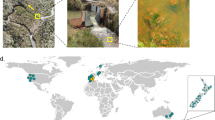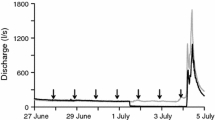Abstract
Current velocity is a pervasive feature of lotic systems, yet this defining environmental variable is rarely examined as a factor for regulating stream herbivory. To investigate how current modifies herbivory in the upper Colorado River, U.S.A., loops of electrified fencing wire were used to reduce in situ grazer densities on 30 × 30 cm tile substrates. After 45 d, electrified tiles had significantly fewer grazers (P = 0.03) and >2X more algal biomass than controls (P = 0.0002). Reduced grazing on electrified tiles yielded periphytic assemblages having more diatoms and chlorophytes, as well as greater algal species richness. Current velocity effects alone did not significantly regulate algal abundance; however, the interaction between current velocity and grazer exclusion resulted in more algae in slow vs. fast current (P = 0.02). Grazer abundances were similar between fast and slow current velocities, suggesting that grazers in the Colorado River differ in their ability to regulate algae across the current velocity gradient. Our results indicate that stream current-mediated herbivory in streams may be more important than is generally recognized.
Similar content being viewed by others
References
American Public Health Association, 1992. Standard methods for the examination of water and waste water. 18th. edition. American Public Health Association, Washington D.C.
Arens, W., 1989. Comparative functional morphology of the mouthparts of stream animals feeding on epilithic algae. Archiv für Hydrobiol. Suppl. 83: 253–354.
Bertness, M. D. & R. Callaway, 1994. Positive interactions in communities. Trends Ecol. Evol. 9: 191–193.
Biggs, B. J. F., 1996. Patterns in benthic algae of streams. In Stevenson, J.R., M. I. Bothwell & R. L. Lowe (eds). Algal Ecology: Freshwater Benthic Ecosystems. Academic Press, Inc., San Diego: 31–56.
Biggs, B. J. F., D. G. Goring & V. I. Nikora, 1998. Subsidy and stress responses of stream periphyton to gradients in water velocity as a function of community growth form. J. Phycol. 34: 598–607.
Biggs, B. J. F. & C. W. Hickey, 1994. Periphyton responses to a hydraulic-gradient in a regulated river in New Zealand. Freshwat. Biol. 32: 49–59.
Brown, G. G., R. H. Norris, W. A. Maher & K. Thomas, 2000. Use of electricity to inhibit macroinvertebrate grazing of epilithon in experimental treatments in flowing waters. J. N. Am. Benthol. Soc. 19: 176–185.
Cardinale, B. J., K. Nelson & M. A. Palmer, 2000. Linking species diversity to the functioning of ecosystems: on the importance of environmental context. Oikos 91: 175–183.
DeNicola, D. M. & C. D. McIntire, 1990. Effects of substrate relief on the distribution of periphyton in laboratory streams. 1. Hydrology. J. Phycol. 26: 624–633.
DeNicola, D.M. & C. D. McIntire, 1991. Effects of hydraulic refuge and irradiance on grazer-periphyton interactions in laboratory streams. J. N. Am. Benthol. Soc. 10: 251–262.
Dodd, J. J., 1987. The Illustrated Flora of Illinois: Diatoms. Southern Illinois University Press., Carbondale.
Dodds, W. K. & J. L. Marra, 1989. Behaviors of the midge, Cricotopus (Diptera; Chironomidae) related to mutualism with Nostoc parmeloides (Cyanobacteria). Aquat. Insects 11: 201–208.
Downes, B. J., P. S. Lake, E. S. G. Schreiber & A. Glaister, 2000. Habitat structure, resources and diversity: the separate effects of surface roughness and macroalgae on stream invertebrates. Oecologia 123: 569–581.
Dudley, T. L. & C. M. D'Antonio, 1991. The effects of substrate texture, grazing, and disturbance on macroalgal establishment in streams. Ecology 72: 297–309.
Feminella, J. W. & C. P. Hawkins, 1995. Interactions between stream herbivores and periphyton: a quantitative analysis of past experiments. J. N. Am. Benthol. Soc. 14: 465–509.
Feminella, J. W. & V. H. Resh, 1991. Herbivorous caddisflies, macroalgae, and epilithic microalgae: dynamic interactions in a stream grazing system. Oecologia 87: 247–256.
Gawne, B., 1997. Inconsistency in the experimentally derived relationship between epilithon abundance and the micro-distribution of Agapetus monticolus (Trichoptera). Aust. J. Ecol. 22: 325–333.
Gordon, N. D., T. A. McMahon & B. L. Finlayson, 1992. Stream hydrology: an introduction for ecologists. John Wiley & Sons, Chichester.
Gregory, S. V., 1983. Plant-herbivore interactions in stream systems. Pages 157-189 In Barnes J. R. & G. W. Minshall (eds), Stream Ecology. Plenum Press, New York: 157–189.
Hansen, R. A., D. D. Hart & R. A. Merz, 1991. Flow mediates predator-prey interactions between triclad flatworms and larval black flies. Oikos 60: 187–196.
Hart, D. D., 1985. Causes and Consequences of Territoriality in a Grazing Stream Insect. Ecology 66: 404–414.
Hart, D. D., 1992. Community organization in streams – the importance of species interactions, physical factors, and chance. Oecologia 91: 220–228.
Hart, D. D. & C. M. Finelli, 1999. Physical-biological coupling in streams: The pervasive effects of flow on benthic organisms. Ann. Rev. Ecol. Syst. 30: 363–395.
Hillebrand, H., C. D. Durselen, D. Kirschtel, U. Pollingher & T. Zohary, 1999. Biovolume calculation for pelagic and benthic microalgae. J. Phycol. 35: 403–424.
Kohler, S. L. & M. A. McPeek, 1989. Predation risk and the foraging behavior of stream insects. Ecology 70: 1811–1825.
Lamberti, G. A., 1996. The role of periphyton in benthic food webs. In Stevenson, J. R., M. I. Bothwell & R. L. Lowe (eds), Algal Ecology: Freshwater Benthic Ecosystems. Academic Press, Inc., San Diego: 533–572
Merritt, R. W. & K. W. Cummins, 1996. An introduction to the aquatic insects of North America. 3rd edition. Kendal/Hunt Publishing Co., Dubuque, Iowa.
Mesick, C. F. & J. C. Tash, 1980. Effects of electricity on some benthic stream insects. Trans. Am. Fish. Soc. 109: 416–422.
Minshall, G. W., 1978. Autotrophy in stream ecosystems. Bioscience 28: 767–771.
Odum, E. P., J. T. Finn & E. H. Franz, 1979. Perturbation theory and the subsidy-stress gradient. Bioscience 29: 349–352.
Palmer, T. M., 1995. The Influence of spatial heterogeneity on the behavior and growth of two herbivorous stream insects. Oecologia 104: 476–486.
Passey, S. I., 2001. Spatial paradigms of lotic diatom distribution: a landscape ecology perspective. J. Phycol. 37: 370–378.
Peckarsky, B. L., 1996. Alternative predator avoidance syndromes of stream-dwelling mayfly larvae. Ecology 77: 1888–1905.
Poff, N. L., N. J. Voelz, J. V. Ward & R. E. Lee, 1990. Algal colonization under four experimentally-controlled current regimes in a high mountain stream. J. N. Am. Benthol. Soc. 9: 303–318.
Poff, N. L. & J. V. Ward, 1991. Drift responses of benthic invertebrates to experimental streamflow variation in a hydrologically stable stream. Can. J. Fish. Aquat. Sci. 48: 1926–1936.
Poff, N. L. & J. V. Ward, 1992. Heterogeneous currents and algal resources mediate in situ foraging activity of a mobile stream grazer. Oikos 65: 465–478.
Poff, N. L., T. Wellnitz & J. Monroe, 2003. Redundancy among stream grazers across a current velocity gradient. Oecologia 134: 262–269.
Power, M. E., 1992. Hydrologic and trophic controls of seasonal algal blooms in northern California rivers. Archiv für Hydrobiol. 125: 385–410.
Pringle, C. M. & G. A. Blake, 1994. Quantitative effects of atyid shrimp (Decopoda: Atyidae) on the depositional environment in a tropical stream: use of electricity for experimental exclusion. Can. J. Fish. Aquat. Sci. 51: 1443–1450.
Rader, R. B. & J. V. Ward, 1987. Resource utilization, overlap and temporal dynamics in a guild of mountain stream insects. Freshwat. Biol. 18: 521–528.
Reynolds, J. B., 1996. Electrofishing. In Murphy, B. R. & D. W. Willis (eds), Fisheries Techniques. American Fisheries Society, Bethesda, MD: 221–253.
Rosemond, A. D. & S. H. Brawley, 1996. Species specific characteristics explain the persistence of Stigeoclonium tenue (Chlorophyta) in a woodland stream. J. Phycol. 32: 54–63.
Sokal, R. R. & F. J. Rohlf, 1995. Biometry. 3rd. edition. W. H. Freeman & Co., New York.
Steinman, A. D., 1991. Effects of herbivore size and hunger level on periphyton communities. J. Phycol. 27: 54–59.
Steinman, A. D., 1996. Effects of grazers on freshwater benthic algae. In Stevenson, J. R., M. I. Bothwell & R. L. Lowe (eds), Algal Ecology: Freshwater Benthic Ecosystems. Academic Press, Inc., San Diego: 341–366.
Steinman, A. D. & G. A. Lamberti, 1996. Biomass and pigments of benthic algae. In Hauer, F. R. & G. A. Lamberti (eds). Methods in Stream Ecology. Academic Press, San Diego: 295–313.
Stevenson, R. J., 1996. The stimulation and drag of current. In Stevenson, J. R., M. Bothwell & R. L. Lowe (eds), Algal Ecology: Freshwater Benthic Ecosystems. Academic Press, Inc., San Diego:321–340.
Stevenson, R. J., C. G. Peterson, D. B. Kirschtel, C. C. King & N. C. Tuchman, 1991. Density-dependent growth, ecological strategies, and the effects of nutrients and shading on benthic diatom succession in streams. J. Phycol. 27: 59–69.
Swan, C. M. & M. A. Palmer, 2000. What drives small-scale spatial patterns in lotic meiofauna communities? Freshwat. Biol. 44: 109–121.
Taylor, B.W., A. R. McIntosh & B. L. Peckarsky. 2002. Reach-scale manipulations show invertebrate grazers depress algal resources in streams. Limnol. Oceanogr 47: 893–899.
Taylor, B.W., A. R. McIntosh & B. L. Peckarsky, 2001. Sampling stream invertebrates using electroshocking techniques: implications for basic and applied research. Can. J. Fish. Aquat. Sci. 58: 437–445.
Tuchman, M. L. & R. J. Stevenson, 1980. Comparison of clay tile, sterilized rock, and natural substrate diatom communities in a small stream in southeastern Michigan, U.S.A. Hydrobiologia 75: 73–79.
Walker, B., A. Kinzig & J. Langridge, 1999. Plant attribute diversity, resilience, and ecosystem function: the nature and significance of dominant and minor species. Ecosystems 2: 95–113.
Wellnitz, T. & N. L. Poff, 2001. Functional redundancy in heterogeneous environments: implications for conservation. Ecol. Lett. 4: 177–179.
Wellnitz, T. A., N. L. Poff, G. Cosyleon & B. Steury, 2001. Current velocity and spatial scale as determinants of the distribution and abundance of two rheophilic herbivorous insects. Landscape Ecol. 16: 111–120.
Wellnitz, T. A. & J. V. Ward, 1998. Does light intensity modify the effect mayfly grazers have on periphyton? Freshwat. Biol. 39: 135–149.
Wellnitz, T. A. & J. V. Ward, 2000. Herbivory and irradiance shape periphytic architecture in a Swiss alpine stream. Limnol. Oceanogr. 45: 64–75.
Author information
Authors and Affiliations
Corresponding author
Rights and permissions
About this article
Cite this article
Opsahl, R.W., Wellnitz, T. & LeRoy Poff, N. Current velocity and invertebrate grazing regulate stream algae: results of an in situ electrical exclusion. Hydrobiologia 499, 135–145 (2003). https://doi.org/10.1023/A:1026317230183
Issue Date:
DOI: https://doi.org/10.1023/A:1026317230183




